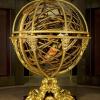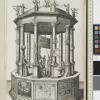Prague, 1584: Celestial globe clock
Commentary
Celestial globe clock, of gilt metal, made in Augsburg in 1584 by Georg Roll and Johannes Reinhold, and purchased by Rudolf II on Christmas 1584.
Dimensions. Celestial globe: diameter: 30.4 cm
Source: Victoria and Albert Museum, London: museum number 246-1865; gallery location: Medieval and Renaissance, room 62, case 6.
Function. This globe is a mechanical model of the cosmos, simulating the movements of the sun, moon, and stars. Winding the crank (at the lower end of the axis) turned the internal clockwork mechanism (shown in Image 4), which moved the hands of the clock at the opposite pole, with separate faces for hours and minutes, as well as the globe itself, engraved with the constellations, each identified by punched lettering. The clock could also be used to display the positions of the celestial bodies at any time in the past or future and could tell the time by the position of the stars. When used as a clock, the hours were struck on an internal bell, audible through holes pieced in the base.
Status. Needless to say, such a clock was regarded, not simply a timekeeping mechanism, but as a display of the maker’s craftsmanship and technical ingenuity and the owner’s material wealth and intellectual sophistication. It was intended to impress, to educate, to delight, and to inform in equal measure. During the latter sixteenth century, it became fashionable for wealthy members of the highest social orders to have a sound understanding of all branches of learning, from art and literature to mathematics and the natural sciences. Clocks such as this were housed alongside automatons and scientific instruments such as astrolabes and sundials in collections of instrumentalia or scientifica, which celebrated the growing human capacity to comprehend, control, and imitate nature.
Association with Rudolf II. The celestial globe rests on a stand with four legs in the form of dragons, each with a single ball and claw foot. An engraved cartouche contains the signature of the makers. On an orb between the globe and the legs is engraved a crowned, double-headed eagle, suggesting that it was made for a member of the Habsburg family. This clock was in fact bought by Emperor Rudolf II at Christmas in 1584. Rudolph II's clocks and instruments were amongst his most treasured collections. He owned around 60 clocks and 120 astronomical and geometrical instruments.
Habsburg competition. A similar globe by the same makers was bought during the same year by the Emperor's brother, Archduke Ernst, for a price greater by some 300 thaler. The Emperor accused its maker, Georg Roll, of selling him an inferior piece and instructed the Augsburg city council to imprison him for treating him 'in a scurvy manner'. In a lengthy appeal to the Emperor, Roll explained that the two globes were almost identical and that the Emperor was offered his at a lower price merely because Roll was seeking further business at the Imperial court, an explanation which the Emperor begrudgingly accepted for the sake of the twenty-five journeymen whom Roll employed. On Ernst's death, Rudolf obtained most of his brother’s collection, and the descriptions of two globes in an inventory of Rudolph's collections, dated 1607-11, probably refer to this pair. The other clock, retained in the matchles collection of Habsburg treasures in the Kunsthischorisches Museum in Vienna, is more elaborately painted, more dellicately mounted, and include several features no longer evident in the V&A's clock: Roll's protestantions to the contrary, it is clear that Archduke Ernst had obtained the finer specimen.
The V&A's celestial globe clock. The V&A's example is missing parts described in the inventory, including a small sphere, as well as the original base and finials. Several parts of the mechanism are also missing, including the sun and its driving ring, the telescopic connection between the sphere, and the calendar ring and the hour hand on the clock (the minute hand is a replacement). Comparison with the closest surviving example in the Kunsthistorisches Museum in Vienna suggests that this clock may once have had a standing figure at the top, a lower globe inside the stand and an ebony base with a magnetic compass and four sundials. Some of the details can be more clearly seen on the similar clock in Vienna. J.F. Hayward suggests that the missing piece of the V&A’s clock might result from damage sustained during the looting of the Imperial collections in Prague by Swedish troops in 1648, at the very end of the Thirty Years’ War (J. F. Hayward, 'The Roll and Reinhold Celestial Globe of the Emperor Rudolph II", Connoisseur, June 1973, pp. 94-96).
Other celestial globe clocks. In addition to the globes in London and Vienna, four other variations of this model have survived:
3. Dated 1586: Staatliche Kunstammlungen, Dresden: Inv. no. E II 2
4. Dated 1588: Conservatoire National des Arts et Métiers, Paris: here.
5. Dated 1589: Osservatorio Astronomico di Capodimonte, Naples
6. Undated: Hermitage, St. Petersburg
One of these globes is depicted in Jan Brueghel the Elder's Sense of Hearing (1618, from his series on The Five Senses), now in the Prado, Madrid, on which a commentary is available (in Spanish with English subtitles).
Smaller celestial globes, made by Jost Bürgi (1552 - 1632) in Kassel in 1585, 1592 and 1594, are now in the Anna Amalia Bibliothek in Weimar, the Astronomisch-Physikalisches Kabinett in Kassel, and the Schweizerisches Nationalmuseum in Zurich, no. LM-59000.1
Resources
A brief video featuring the V&A’s clock is available at http://www.vam.ac.uk/content/articles/r/rudolph-ii-and-prague/
A variety of other Cosmic Machines are featured in the rich online resources of the Museo Galileo.
Spheres: The Art of the Celestial Mechanic, an exhibition catalogue from Galerie J. Kugel in Paris.
Credit: Most of the text used here is based on the extensive description of this object in the V&A, which also lists further literature. Howard Hotson (November 2016)


